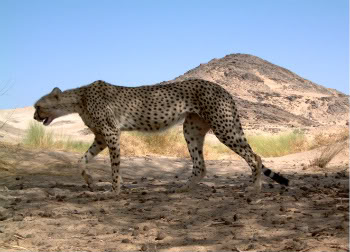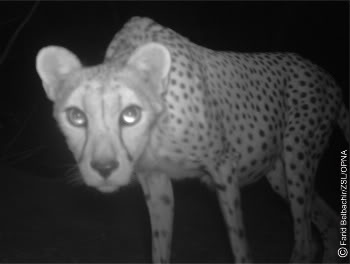On the edge of extinction, desert-dwelling cheetah photographed for first time by camera traps
With only 250 individuals left the Saharan Cheetah is on the brink of extinction. Little-studied, this imperiled subspecies has been photographed for the fist time by scientists from by the Zoological Society of London (ZSL) and Office du Parc National de l’Ahaggar (OPNA) using camera traps.
“The Saharan cheetah is critically endangered, yet virtually nothing is known about the population, so this new evidence, and the ongoing research work, is hugely significant,” said Dr Sarah Durant, a Senior Research Fellow with ZSL.
 Saharan cheetah. Photo by Farid Belbachir. |
Four individual Saharan Cheetahs were identified from the camera traps, which were set in Algeria. Scientists were able to separate the individuals by unique spot patterns.
The Saharan cheetah, also called the Northwest African cheetah, roams the desert and savannahs of North and West Africa. Five nations beside Algeria may contain the subspecies, including Niger, Benin, Burkina-Faso, Mali, and Togo. It is believed that Algeria possesses the largest populations.
“This is an incredibly rare and elusive subspecies of cheetah and current population estimates, which stand at less than 250 mature individuals, are based on guesswork,” says Farid Belbachir, who is implementing the field survey. “This study is helping us to turn a corner in our understanding, providing us with information about population numbers, movement and ecology.”
“This first camera-trap confirmation of cheetahs in Algeria is a landmark success toward our efforts to save these big cats,” added Dr. James Deutsch, Director of the Wildlife Conservation Society’s Africa Program which, together with Panthera, helped support the camera trapping survey. “Findings like these help us refine our conservation strategies for the cheetah across its entire range.”
 Saharan cheetah caught by a camera trap. Photo by Farid Belbachir. |
Scientists plant to work with Saharan nomadic pastoralists, the Tuareg, to uncover what this desert-dwelling community knows about the Saharan cheetah and its threats.
The photos of the Saharan cheetah are apart of a systematic camera trap survey of the central Saharan desert, which has made additional discoveries. Photos have confirmed that the sand cat inhabits Algeria as well. Researchers also uncovered past evidence of Scimitar-horned oryx, which is extinct in the wild due to poaching for its distinctive horns. The species only survives in captivity.
With luck and continuing research such a fate may be avoided by the Saharan cheetah.
Related articles
Did cheetah come from China?
(12/29/2008)
The discovery of a fossilized big cat skull in northwestern China provides new evidence that cheetah originated in the Old World, rather than the Americas, report scientists writing in the journal Proceedings of the National Academy of Sciences.
Cheetah population declines 90% in 100 years:
An interview with Rebecca Klein of Cheetah Conservation Botswana
(09/30/2008)
The planet’s fastest land animal is falling behind in its race for survival against habitat encroachment, loss of prey, the illegal wildlife trade, and human-wildlife conflict.
Cheetah in Iran?
(03/01/2007)
Biologists from the Wildlife Conservation Society (WCS) have fitted critically endangered cheetahs in Iran with Global Positioning System (GPS) collars. This marks the first time this population of Asiatic cheetah can be tracked remotely.







